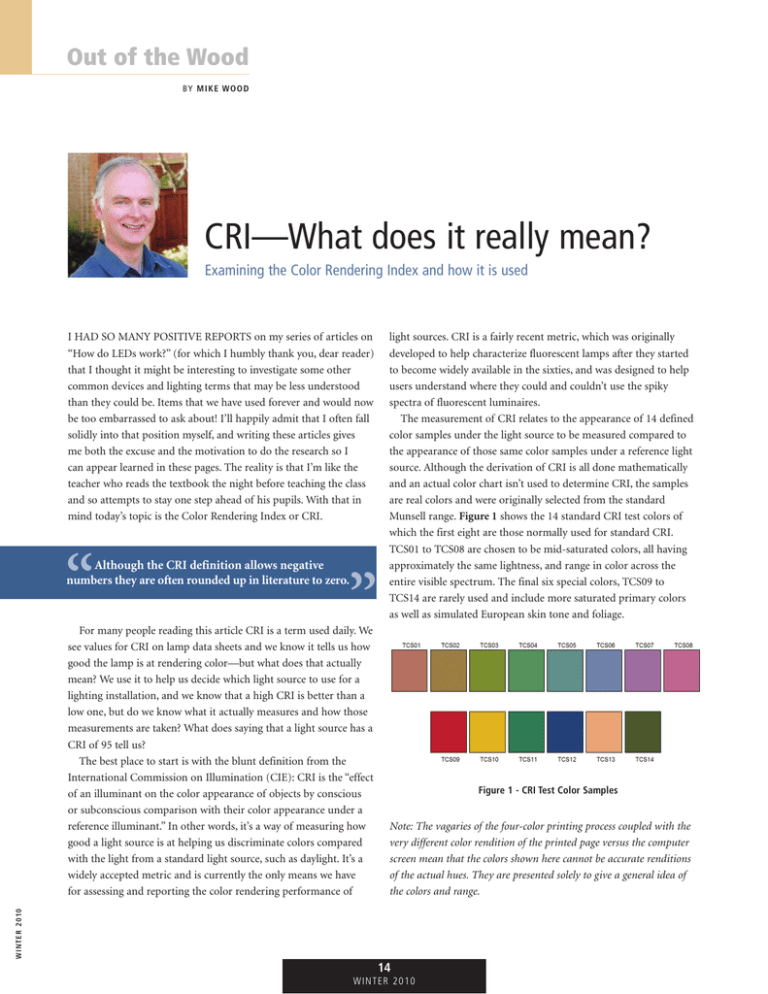CRI—What does it really mean?
advertisement

Out of the Wood BY MIKE WOOD CRI—What does it really mean? Examining the Color Rendering Index and how it is used I had so many positive reports on my series of articles on “How do LEDs work?” (for which I humbly thank you, dear reader) that I thought it might be interesting to investigate some other common devices and lighting terms that may be less understood than they could be. Items that we have used forever and would now be too embarrassed to ask about! I’ll happily admit that I often fall solidly into that position myself, and writing these articles gives me both the excuse and the motivation to do the research so I can appear learned in these pages. The reality is that I’m like the teacher who reads the textbook the night before teaching the class and so attempts to stay one step ahead of his pupils. With that in mind today’s topic is the Color Rendering Index or CRI. “ “ Although the CRI definition allows negative numbers they are often rounded up in literature to zero. Figure 1 - CRI Test Color Samples Note: The vagaries of the four-color printing process coupled with the very different color rendition of the printed page versus the computer screen mean that the colors shown here cannot be accurate renditions of the actual hues. They are presented solely to give a general idea of the colors and range. W I NT E R 2 0 1 0 For many people reading this article CRI is a term used daily. We see values for CRI on lamp data sheets and we know it tells us how good the lamp is at rendering color—but what does that actually mean? We use it to help us decide which light source to use for a lighting installation, and we know that a high CRI is better than a low one, but do we know what it actually measures and how those measurements are taken? What does saying that a light source has a CRI of 95 tell us? The best place to start is with the blunt definition from the International Commission on Illumination (CIE): CRI is the “effect of an illuminant on the color appearance of objects by conscious or subconscious comparison with their color appearance under a reference illuminant.” In other words, it’s a way of measuring how good a light source is at helping us discriminate colors compared with the light from a standard light source, such as daylight. It’s a widely accepted metric and is currently the only means we have for assessing and reporting the color rendering performance of light sources. CRI is a fairly recent metric, which was originally developed to help characterize fluorescent lamps after they started to become widely available in the sixties, and was designed to help users understand where they could and couldn’t use the spiky spectra of fluorescent luminaires. The measurement of CRI relates to the appearance of 14 defined color samples under the light source to be measured compared to the appearance of those same color samples under a reference light source. Although the derivation of CRI is all done mathematically and an actual color chart isn’t used to determine CRI, the samples are real colors and were originally selected from the standard Munsell range. Figure 1 shows the 14 standard CRI test colors of which the first eight are those normally used for standard CRI. TCS01 to TCS08 are chosen to be mid-saturated colors, all having approximately the same lightness, and range in color across the entire visible spectrum. The final six special colors, TCS09 to TCS14 are rarely used and include more saturated primary colors as well as simulated European skin tone and foliage. 14 W I NT ER 2 0 1 0 Out of the Wood | CRI—What does it really mean? Figure 2 - CRI Test Color Samples spectra Figure 2 shows the spectra of the first eight colors—again you can see that these are complex spectra that you would find with real objects and pigments. They aren’t artificially defined computer colors. It is important to understand that, although the CRI color samples are carefully specified and could be produced as real physical articles, the derivation of CRI is completely computational. You don’t have to shine a real light at real color chips. Instead you work with the measured spectra of the light source and the defined spectra of the color samples and derive the CRI through mathematical analysis. Thus, the measurement of CRI is quantitative and objective, it’s not a subjective measure relying on a trained observer trying to decide if one light is better than another. For a comparison based on perceived color to be meaningful, the color temperatures of both the test light source and the reference light source have to be the same. For example, it would be a waste of time trying to compare the appearance of two color samples one of which was illuminated with a warm 2900K light while the other was lit with a cool 5600K daylight source. We know they’d look different! So the first step is to calculate the correlated color temperature (CCT) of the test light source from its spectrum. Once we have that color temperature, a reference light source of the same color temperature is mathematically created. For color temperatures below 5000 K the reference light source is a black body (Planckian) radiator, while for temperatures above 5000 K a CIE Daylight illuminant is used. We can now combine the spectra of the reference light source and each of the test colors to generate an ideal resultant color point for each. The same is done for our light under test, combining the test light source with the test colors to produce a second set of color points. If the color points from the test light source are identical to those from the reference light source then we say that the color rendering is identical and the CRI is defined as 100. The further away on the color chart each of the test points is from their ideal position, then the worse the color rendering and the lower the CRI value. These distance errors for the eight color samples are independently calculated and averaged to get the final CRI figure. A perfect score of 100 represents no color differences in any of the eight samples under the test source and reference illuminant. That’s a lot of words and has probably confused more than it’s aided, so I think a few pictures will help a lot. Let’s start with a source with perfect color rendering of 100, an incandescent lamp. (An incandescent lamp is theoretically a black body radiator so it has perfect color rendering by definition.) Figure 3 shows the test and reference color points plotted on a color chart while Figure 4 shows the appearance of the color samples. The test color points are identical to the reference so appear overlaid as single points on the diagram. WI N T E R 2 0 10 15 p r oto c o l Out of the Wood | CRI—What does it really mean? Figure 3 - Incandescent lamp color points CRI 100 Note: Real incandescent lamps actually have CRI values that are less than 100. Slight coloration from the envelope and materials used in the lamp manufacture such as the halides in tungsten halogen lamps lower the CRI. For true 100 you need a bare filament, which doesn’t last very long! For contrast Figure 5 and Figure 6 show the same data for a mercury lamp which has a fairly poor CRI of 43. Figure 4 - Incandescent lamp color samples Figure 5 - Mercury lamp color points - CRI 43 Figure 6 - Mercury lamp color samples W I NT E R 2 0 1 0 You can see that the discontinuous and spiky spectrum of a mercury lamp with just a few major spectral lines tends to exaggerate some colors, such as the yellowy-green TCS03, and under represent others, such as the bluish green TCS05, so that they appear washed out and almost grey. None of the test colors are correctly represented and the errors are quite large. At the other extreme of color rendering we have the low pressure sodium lamp in Figure 7 and Figure 8. These are the older orange-yellow lamps typically used in street lighting. They are essentially monochromatic with two dominant yellow spectral lines very close together at 589.0 and 589.6 nm. 16 W I NT ER 2 0 1 0 Out of the Wood | CRI—What does it really mean? Table 1 gives examples of approximate CRIs from a range of light sources. Table 1: CRI values for common lamps Figure 7 - Low Pressure Sodium lamp color points - CRI -47 Color Temperature CRI Candle 1700K 100 CRI Low pressure Sodium 1700K -47 CRI High Pressure Sodium 2100K 25 CRI Domestic incandescent lamp 2700K 95-97 CRI Tungsten Halogen 3200K 96-98 CRI Fluorescent 2700 - 6500K 55-90 CRI Metal Halide lamps 4000K - 7000K 60-95 CRI Natural Sunlight 5000-6000K 100 CRI CRI isn’t by any means a perfect measure. It really only tells you how a light source will perform in a narrow band of mid saturated colors, and it is best with sources that lie near to the black body line and that don’t have too high or too low a color temperature. Nor is it a universal measure. An incandescent lamp may score a perfect 100 for CRI but we know that it is a poor choice of lamp if we are trying to discriminate between deep blues. There just isn’t the blue energy in the lamp. Daylight would be a much better choice for blues, but that same bluish daylight may not be the best choice if you are looking at deep reds. In reality no one light source at a single color temperature can be ideal for color discrimination across all areas of the spectrum. Instead, we try and pick a measure that gives us an indication of performance in the commonest areas. Recently the introduction of new light sources, in particular LEDs, has put the core definition of CRI under even more scrutiny. CRI wasn’t designed as a measure for white light produced in the way that an RGB LED combination does it, and when CRI is applied to LEDs it can produce misleading results. For example, because the eight indices for the individual test colors are averaged together to produce the final CRI, a light source can score well Figure 8 - Low Pressure Sodium lamp color samples The low pressure sodium lamp has no color rendering ability at all and actually has a calculated CRI of ‑47! All eight test color samples appear as shades of the same muddy yellow. This explains why it’s so hard to find your car at night in a parking lot lit with these lamps. No matter what color your car is, under low pressure sodium they all look the same. (Although the CRI definition allows negative numbers they are often rounded up in literature to zero. “ “ Source An incandescent lamp may score a perfect 100, but we know that it is a poor choice of lamp if we are trying to discriminate between deep blues . . . That’s deemed to be bad enough!) Low pressure sodium lamps present somewhat of a dilemma to the responsible lighting designer. They are still just about the most efficient light source around with efficacies up to 150 lm/W but are universally disliked because of their unpleasant appearance and non-existent color rendering. In many installations they have been replaced with slightly less efficient high pressure sodium and other sources with better CRIs. WI N T E R 2 0 10 17 p r oto c o l Out of the Wood | CRI – What does it really mean? Out of the Wood | CRI— What does it really mean? even though it renders one or two colors poorly. With the large gap in the yellow wavelengths when using RGB LEDs they can do a bad job of rendering yellows but still get a respectable CRI. Additionally, because the eight standard sample colors are all of fairly low saturation, the CRI tells you nothing about how a light source will perform when rendering deeply saturated colors. The widely separated and narrow peaks of the spectra from RGB LEDs can perform poorly when rendering saturated colors outside those peaks, but the current CRI definition doesn’t pick up that deficiency. As we know, RGB LEDs have the potential to be highly energy efficient, but poor color rendering could inhibit their market acceptance. Small changes in the wavelengths and bandwidths of the LED emitters used can significantly affect the color rendering of the combination, so developers of luminaires using these light sources need an effective metric to evaluate the color rendering of their products. Seemingly similar RGB LEDbased luminaires can have CRIs that vary from a poor 40 up to a very respectable 80, but which, if any, of these values truly represents the color rendering of the light output? The problems with CRI and solid state lighting have been recognized and a new metric, CQS or Color Quality Scale, is under development by the National Institute of Standards and Technology (NIST) to address these and other concerns. I’ve just scraped the surface of the issue of color rendering of LEDs and the move towards using CQS. This is a much larger and interesting topic than I have space for here and will form Part 2 of this series. To be continued…. n Credits: Many thanks to Wendy Davis at NIST for permission to reproduce text and figures from NIST documents. W I NT E R 2 0 1 0 Mike Wood is P resident of Mike Wo o d Consulting LLC which provides cons u l t i n g support to companies within the en t e r t a i n m e n t industry on tec hnology strategy, R&D, sta n d a rd s, and Intellectual Property. A 30-year v e t e ra n o f the entertainment technology indust r y, M i ke i s the Treasurer and Immediate Past Pr e s i d e n t o f ESTA. Mike c an be reac hed at 512.2 88. 4916. 18 W I NT ER 2 0 1 0



